Naval Nuclear Power - Swartz Creek Community Schools
advertisement
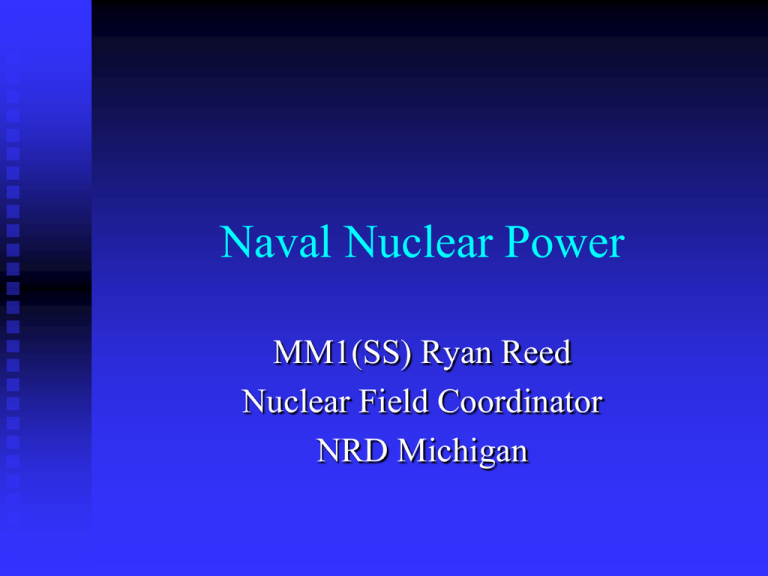
Naval Nuclear Power MM1(SS) Ryan Reed Nuclear Field Coordinator NRD Michigan R TH E O IL O AS G O HY DR CL E AL NU 55% COAL 100 90 22% NUCLEAR 80 10% NATURAL 70 60 GAS 50 40 9% HYDRO 30 3% PETROL. 20 1% SOLAR, WIND, 100 BIOMASS, GEOTHERMAL CO AR POWER GENERATION BREAKDOWN What is nuclear power? Extracting usable energy from atomic nuclei via controlled nuclear reactions. History Fission experimentally achieved by Enrico Fermi in 1934 by bombarding uranium with neutrons. First nuclear power plant used for civil purpose was launched in 1954 The Navy’s first nuclear powered ship USS Nautilus was put to sea in 1955 So why would the Navy want to use Nuclear Power? Efficiency Zero emissions Longevity ENERGY EQUIVALENCY CONS OF FOSSIL FUEL SOURCES COAL NATURAL GAS OIL PROS & CONS OF RENEWABLE SOURCES SOLAR WIND BIO-MASS GEO-THERMAL Coal vs. Nuclear Power How long can one pound of coal light one 100 watt light bulb, once all of its energy is converted to electricity? Approximately 9 hours How long can one pound of uranium light the same bulb? 3,000 YEARS!!!!! Nuclear power plants use a series of physical barriers to make sure radioactive material cannot escape. In today’s water-cooled reactors, the first barrier is the fuel itself: the solid ceramic uranium pellets. The pellets are sealed in zirconium rods. Why do you think the Navy takes advantage of this technology? Prior to this, submarines relied on diesel generators to charge the ships batteries. This limited the submarine submergence time to a maximum of 12 hours before it would have to resurface and recharge. Today, submarines have the ability to stay submerged and perform several types of missions without being detected for up to 90 days (limited on food and supplies)!! Longevity Navy’s nuclear ships can run for decades without refueling. Allowing our submarines to remain submerged, and aircraft carriers to stay on station without having to return to port to refuel. Why can an atom produce so much energy? First, consider the type of reaction that is taking place? Second, what are the individual particles that make-up the atom? Which particles are in the nucleus and what electrical charge do they possess? What holds the nucleus together? Nuclear Physics “Nuclear Strongforce” The nucleus always has a smaller total mass than the sum of its component masses. That is if you weighed the protons and neutrons individually they would weigh a total of 235 atomic mass units. However, when grouped to form the nucleus some of the mass is converted to energy (nuclear strongforce) holding it together which makes it weigh less. This is derived from: E = mc2 Nuclear Physics “Fission” What causes fission to occur? Nuclear Physics “Fission” Addition of a neutron to the nucleus, causes it to become unstable. In order for the nucleus to reach stability again, it fissions (breaks apart) releasing the energy (nuclear strongforce) in the form heat. Also, 2 to 3 more neutrons are released. Basic fission reaction 235 92 1 U + 0n 236 92 U * 134 100 1 54 38 0 Xe + Sr + n + 1 0 n + E Nuclear Physics “Fission” Are the neutrons “born” from fission important? Yes! They go on to cause more fissions to keep the chain reaction continuing. Basic Nuclear Reaction (Fission) Xenon Xenon U 235 Xenon U 235 Strontium Strontium = Neutron = energy released (heat) U 235 Strontium = Fission Products Nuclear Physics If one neutron produces one fission and three neutrons are “born” and they cause three fissions to occur how many do we having at the beginning of the third generation? 9 Fourth and so on? 27, 81, 243, 729, 2187 How is the reactor responding to this increase in neutron population per generation? It is increasing at an exponential rate, resulting in the reactor to operate near or above its designed limits. Nuclear Physics To control the neutron population within the reactor, operators use control rods which are made of nonfissionable materials such as Boron or Hafnium. These elements are “neutron sponges” they can absorb neutrons, to prevent them from interacting with Uranium. The control rods are remotely controlled and can be raised and lowered to control the neutron population within the reactor. At steady state levels of operation, one neutron causes a fission, an only 1 of 3 born from fission goes onto to cause another fission. This is called “criticality”. CONTROL ROD THREADED SHAFT FOR DRIVE MOTOR CONTROL RODS ARE MADE OF A MATERIAL WITH A VERY HIGH PROBABILITY OF NEUTRON ABSORPTION, USUALLY BORON OR HAFNIUM. THIS ALLOWS THE CONTROL RODS TO BE RAISED AND LOWERED IN THE REACTOR CORE TO CONTROL THE RATE AT WHICH FISSION OF U-235 OCCURS. THE RODS ARE CONTROLLED AS A GROUP BY MOTORS AND ELECTRONICS FROM A LOCATION AWAY FROM THE REACTOR. CONTROL ROD TOP VIEW OF REACTOR CORE WITH CONTROL RODS AND FUEL CELLS OUT CRDM CONTROL ROD FUEL CELL IN How do we do it??? The Nuclear Reactor Made of Corrosion Resistant Stainless Steel Built to withstand high temperature and pressure Initial Containment for radioactive material We then convert the heat from the fission reaction to steam in a steam generator. The primary coolant passes through tubes which have cooler secondary coolant sprayed on them. The secondary coolant flashes to high pressure steam. Steam produced Heat The steam then flows down a pipe where it will turn generators to generate electricity and on ships to turbines. The steam will spin the turbines at a high rate of speed. This will be reduced by reduction gears to a useful speed to turn the shaft and ultimately the screw on a ship or submarine to propel the vessel through the water. Steam Generator Turbine Completing the Cycle The steam, which is now low pressure and exhausted of its’ energy, is condensed back to secondary coolant. This secondary coolant is pumped back into the steam generator to be used again. The primary coolant, after transferring its’ energy, is pumped back through the core repeating the cycle. NUCLEAR REACTOR OPERATION STEAM SECONDARY SHIELD TURBINE SW OUT CONDENSER REACTOR STEAM GENERATOR PRIMARY SHIELD SW IN COOLANT PUMP REACTOR COMPARTMENT CONDENSATE PUMP Common concerns regarding nuclear energy Explosions Meltdowns Radiation Toxic Waste Mutations TYPES OF RADIATION GAMMA RAYS - no electric charge, most penetrating. ALPHA PARTICLES - identical to a Helium-4 atom, ingestion hazard. BETA PARTICLES - electron with a - or + charge. NEUTRON - no electric charge. BIOLOGICAL EFFECTS KILL OR DESTROY CELLS. GENETIC DEFECTS. CANCER NOTHING. RADIATION LIMITS & EXPOSURE GOVERNMENT NAVY 5,000mrem/yr 500mrem/yr Average exposure working with nuclear power: 150mrem/yr Average exposure received in the United States: 360mrem/yr Medical X-rays: 60mrem/dose Smokers: 1300mrem/yr HEALTH EFFECTS OF RADIATION EXPOSURE 0-25 Rem 25-100 Rem 100-200 Rem 200-600 Rem 600-1000 Rem 1000-2000 Rem None detectable Minor blood changes, nausea, fatigue Disability, blood changes, vomiting. Several weeks to recover Blood changes, internal hemorrhaging, disability, vomiting. 50% die w/o treatment Accelerated symptoms. Death may occur w/in 2 weeks, with delayed mortality of 100% w/o medical treatment 100% fatality w/o medical treatment 1 Rem = 1000mRem ` CHERNOBYL: AN ACCIDENT WAITING TO HAPPEN Boiling Water Reactor Runaway Reactor => 7% to 50% in 3 sec Slow Control Rods Loss of coolant due to operator error Graphite Moderator vice water No Containment RECENT NUCLEAR ACCIDENTS CHERNOBYL-1986 TECHNICIANS REMOVE ALL 30 CONTROL RODS, LOSE CONTROL OF ENERGY ATTEMPT TO SHUT DOWN REACTOR, ONLY INSERT 6 CONTROL RODS RAPID INCREASE OF HEAT CAUSES COOLANT TO EXPLODE INTO STEAM, RUPTURING REACTOR VESSEL CONTAIMENT BUILDING RUPTURES RELEASING RADIOACTIVE MATERIAL CHERNOBYL: AN ACCIDENT WAITING TO HAPPEN RECENT NUCLEAR ACCIDENTS THREE MILE ISLAND- 1979 WORKERS DISABLE CONTROL AIR SYSTEM SECONDARY SYSTEM SHUTS DOWN, LOSS OF WATER IN STEAM GENERATORS REACTOR SCRAMS, PRIMARY SYSTEM OVERHEATS, RELIEF VALVE GETS STUCK OPEN LOSS OF COOLANT IN PRIMARY SYSTEM, CORE IS UNCOVERED FUEL RODS BREAK DOWN RELEASING HYDROGEN INTO REACTOR VESSEL AND BLDG GASES RELEASED TO ATMOSPHERE TO PREVENT HYDROGEN EXPLOSION Three Mile Island Maintenance stopped feedwater to Steam Generators => Rx automatically shutdown Emergency Core Cooling System malfunction Leaking pressure relief valve Partial Meltdown Almost fully contained Turned the tide on public sentiment for Nuclear Power Public Radiation Exposure From Three Mile Island Highest whole body dose to any one individual <100 millirems Dose rate within a 10-mile radius <1.5 mr Dose rate within a 50-mile radius <.5 mr Radioactive Decay Particles a = alpha particle => Helium nucleus with a penetrating power in air of 1-3 cm. Shielded by paper, clothing, dead skin cells. b- = Beta minus => High energy electron with a penetrating power of 17-24cm. Shielded by thick clothing, aluminum foil. g = gamma => photon with an infinite penetrating power, shielded by lead n = neutron => nucleic particle with a high penetrating power, shielding by water The Cookie Question: If you had an alpha, a beta, a gamma, and a neutron cookie, which would you: away a Alpha put in your particle pocket b- Beta particle eat g gamma hold in your hand throw n neutron Cookie Question Answer: Alpha particle: Hold in your hand because it is shielded by dead skin cells. Beta particle: Put in your pocket because it is shielded by thick clothing. Gamma: Eat, because one gamma is very small, and the chances are low that it will even contact any part of your body. Neutron: Throw away because we use water to either moderate or shield neutrons, and your body is made of 70% water. Training Pipeline Upon completion of basic training: “A” school for 13-26 weeks depending on rate. Nuclear Power school for 6 months. Naval Nuclear Prototype training for 6 months in either SC or NY. BENEFITS Entry level bonus- $12,000 cash Advanced promotion to E-3 upon graduation from basic training Advancement to E-4 within 6-9 months (More $$$) College level credit - ~80 credits worth Re-enlistment bonus- up to $120,000, and first time advancement to E-5 (MORE $$$) Technical experience, leadership skills, a security clearance level of “Secret”, and Highly specialized training Great opportunities for Officer selection Any Questions??? MM1(SS) Ryan Reed Phone: 269-270-7314 Email: ryan.t.reed@navy.mil

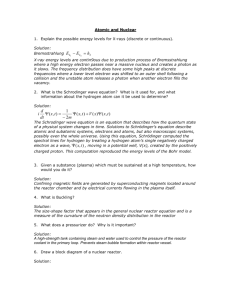
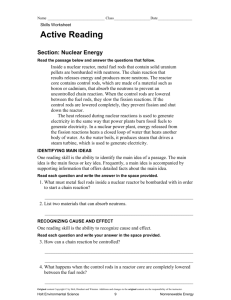


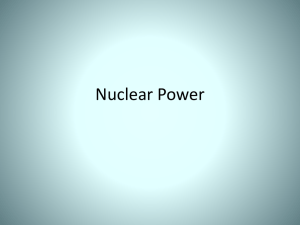
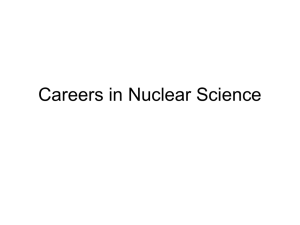


![The Politics of Protest [week 3]](http://s2.studylib.net/store/data/005229111_1-9491ac8e8d24cc184a2c9020ba192c97-300x300.png)
